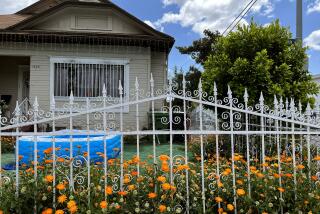Seaside, Fla., Could Be the Model for Tomorrow’s Suburbs : Our Town: It’s a Master Plan to Become Good Neighbors Again
- Share via
SEASIDE, Fla. — This town is Our Town, a new community fashioned from an old America of front porches and back-yard paths, picket fences and brick streets, good neighbors and easy sociability.
This town is also a different town: Those porches and fences are mandated, and lawns, artificial siding and attached garages are forbidden.
Seaside, pop. 203, is a small resort with a big ambition--to revive a style of civic intimacy out of fashion since America moved to the suburbs.
By bringing homes, offices, stores and play areas closer together, Seaside’s tight grid of streets, paths and squares is designed to get people out of their cars and in touch.
If this sounds familiar, it is.
‘Newest Idea in Planning’
“The newest idea in planning is the 19th-Century town,” said architect Andres Duany, whose firm designed Seaside’s master plan and wrote its building code. “Seaside is the only authentic American town to be built in the last 40 years.”
It’s also one of the most celebrated. The Boston Globe’s Robert Campbell, part of the pack of critics, designers and developers who have made the pilgrimage to the Florida Panhandle, calls Seaside “perhaps the most important new piece of architecture in the country.”
“Seaside has no enemies,” Duany gloated. “It’s the old American way of doing things.” He said that because the town plan and building code can be adjusted for any town, “it’s going to be the model for the new suburb.”
At the moment, however, Seaside is at least a decade from completion. Less than a third of its 300 planned houses have been built, and the spaces set aside for a school, church, inn and meeting hall are empty. The town square is a muddy lot. Because it has few year-round residents, Seaside is virtually deserted in winter.
Limits Use of Cars
Although Seaside is designed to limit dependence on the automobile, there is little within walking distance besides a restaurant, a snack bar, a bookstore, a boutique and a one-room post office that houses the five-shelf public library.
What has been built is charming: The pastel wooden cottages range in style from neo-Victorian to plain old Florida cracker, but feel like parts of a whole; the skyline is enlivened by towers, widow’s walks and pitched roofs, all encouraged by the code; the landscaping--indigenous sand and scrub--is natural.
There are many nice details, such as a trellis-shaded chessboard, a gazebo in an intersection, a balcony over the front door of the Department of Public Works shed. Sandy footpaths offer shortcuts between back yards. Houses bear signs with residents’ names, instead of numbers.
This is how Robert Davis dreamed it would be.
Davis, a 44-year-old Birmingham, Ala., native, had visited this area as a boy, building castles in the white sand along the Gulf of Mexico.
In 1978, when he inherited 80 acres about 65 miles east of Pensacola, just west of the village of Seagrove Beach, Davis wanted to build again. But he was revolted by the cold condominium towers sprouting along the water.
He drove around the Southeast, visiting gracious old towns. Equipped with tape measure, notebook and camera, he recorded street widths, building dimensions, architectural types.
The result is Seaside.
‘An Artistic Endeavor’
“This is not an artistic endeavor,” said Duany, who accompanied Davis on some of the trips. “What we’ve done has nothing to do with inspiration. We know how to design because we’ve studied cities and towns that work.”
American town planning and design traditions “seem so dumb and simple,” Davis said. “Why would we ever have gotten away from them?”
Cheap cars, cheap gas and cheap land allowed those who engineered the post-World War II building boom to separate home, market and workplace as never before.
Lessons learned by previous generations--such as the proper ratio of a street’s width to the height of its buildings, or how far an adult with a child will walk to a store--seemed irrelevant.
Duany complained that today’s suburbanites must drive to buy a loaf of bread, play tennis, visit a friend, “even to walk the dog.” If they do step out front, their wide, meandering streets, many without sidewalks, afford an inhospitable meeting place.
As a result, few residents stop to discuss the weather, drink coffee, gossip. If people do not talk, Davis and Duany believe, culture cannot flourish.
Looks to Amiable Past
In its master plan and building code, Seaside looks to a more amiable past; it seeks not only to look like an old town, but to work like one.
Like a traditional Southern town, Seaside’s design includes commercial buildings with sidewalk arcades and offices and apartments on the upper floors; on-street parking, but only one small parking lot; and straight, tree-lined boulevards that connect public places.
Houses are required to have a front porch 16 feet from the street, to encourage conversation between porch sitters and pedestrians. Each front yard must have a fence, and it must be different from the others on the street. Garages must be in back, out of sight.
The lines of fences and houses produce intimate, visually stimulating streets that feel like outdoor rooms. “Human beings are programmed to feel space,” Duany said. “In the wrong kind of space, you feel, ‘What am I doing here?’ ”
“Look at Georgetown,” in Washington, D.C., he said. “People pay incredible prices for substandard plumbing, small rooms and parking three blocks away, just to live on a nice street.”
A Time to Stroll
When the weather is good, Seaside’s residents stroll around, looking at new houses, chatting and generally enjoying themselves. Motorists do not speed because the streets are narrow, slightly bumpy, lined with parked cars and filled with pedestrians.
“You can’t help but meet people,” said Jim Koronkiewicz, an accountant from Long Island whose family vacations at Seaside. “It brings out the best in you.”
The ultimate evidence of Seaside’s success is financial. The cost of a typical 50-by-100-foot lot has risen from $20,000 six years ago to around $70,000 today--twice as much as a lot the same size elsewhere along the coast.
But Seaside is not perfect. In the heat of summer, for instance, most residents seem to prefer the comfort of an air-conditioned living room to the more social climate on the porch.
And back-yard cottages and upstairs apartments, forbidden in most new communities but encouraged by Seaside’s building code, have become too expensive for the kinds of people supposed to live in them, such as domestics and students.
This lack of a socioeconomic mix, Duany said, is “the one signal failure of Seaside. It’s a rich person’s town.”
That leads some to wonder if this seasonal, affluent resort--still more theory than reality--is an appropriate model for the new American suburb.
Duany and Davis have no doubt that Seaside, or at least its master plan and building code, can be transplanted. Even large communities should be broken down into small village clusters, they say.
‘Preaching to Developers’
“We’re preaching to developers and architects that the same elements that go into suburbs can be reformulated into fairly dense little towns,” Davis said.
Duany and his wife and partner, Elizabeth Plater-Zyberk, have fashioned a model ordinance designed to create a Seaside-like “traditional neighborhood district” wherever it is adopted. “We just mail it out,” he said. “If you want to make an impact in this country, you have to kick into mass production.”
But Americans seem to love the privacy and comfort of their cars and suburbs. Given what Columbia University historian Kenneth Jackson called “a national distrust of urban life and communal living,” do they really want to get closer to each other?
“After generations of increasing privatization, Americans are starved for public life,” Davis insisted. “When you step outside your house, you want to see people. It’s scary for our culture that we’ve stopped seeing each other on the street.”
More to Read
Sign up for Essential California
The most important California stories and recommendations in your inbox every morning.
You may occasionally receive promotional content from the Los Angeles Times.






